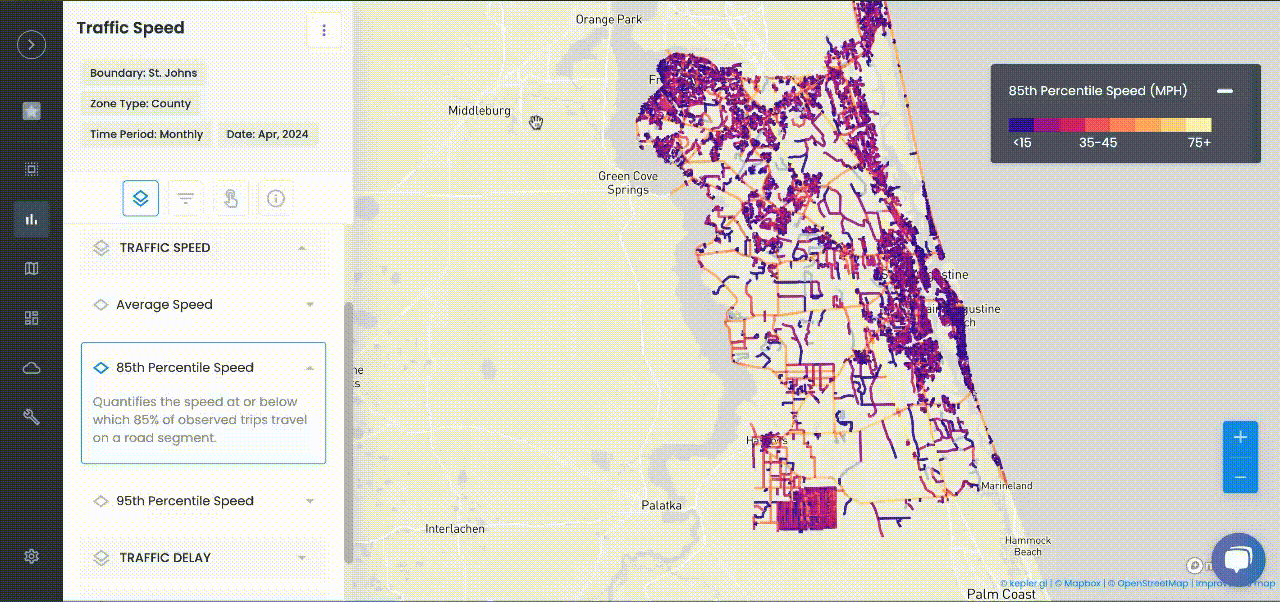
Transportation Planning
Transit‑Oriented Development: Using Data to Plan U.S. Cities around Public Transportation
Cities are planning transit-oriented development using mobility data, ridership insights, and performance metrics for smarter growth.
Transit‑Oriented Development (TOD) is an urban planning approach that focuses growth around transit hubs—typically dense, walkable, mixed‑use neighborhoods near train stations or frequent bus corridors. The goal? Build communities where most daily trips rely on transit, walking, or cycling—reducing car dependency, traffic congestion, and sprawl.
By leveraging data-driven tools—such as transit ridership, land use, population density, and travel behavior metrics—planners can identify prime areas for TOD, forecast ridership gains, and track outcomes like reduced vehicle miles traveled. This ensures resources are directed to areas that will deliver the highest impact.
Identifying TOD Opportunities with Data
One initial step is pinpointing where TOD will work best. Analysts evaluate factors like transit frequency, zoning capacity, demographics, and available land parcels. This often forms the basis of a TOD opportunity index, helping prioritize which station areas are ripe for intervention.
Urban SDK helps streamline this process by combining traffic volume, travel-time delay, and road characteristics data to reveal areas with high transit access but underutilized surrounding land—signal zones ready for TOD.
Predicting Ridership and Impacts
Modern travel demand models can simulate how proposed development affects ridership. For instance, adding new housing units near a transit station can significantly increase transit boardings. Arlington County, VA’s experience shows that properly designed TOD can result in 50% of local residents commuting by transit and 73% walking to the station.
Urban SDK empowers planners with tools to forecast these patterns and monitor real-world trends—helping validate or calibrate predictions as development progresses.
Community Engagement & Interactive Planning
Designing TOD is not just a technical exercise—it requires community input and transparency. Interactive dashboards help residents and planners visualize density, walkable zones, transit service levels, and TOD proposals to compare alternatives.
Urban SDK’s case studies (e.g., the City of El Cajon, CA project) highlight how agencies have used these tools to engage public audiences and illustrate how different growth models impact mobility and safety.
Ensuring Equity through eTOD Planning
Equitable TOD aims to ensure that affordable housing and accessible transit benefits are shared broadly and not limited to affluent areas. Cities track affordability metrics, local incomes, and transit dependency levels to prioritize station areas for inclusive planning.
Urban SDK’s data visualization capabilities allow planners to map and overlay these equity indicators—informing policies that support mixed-income units, reduce displacement risks, and increase transit access in underserved communities.
Monitoring Outcomes
Once TOD developments are complete, data helps verify whether goals are met: Did transit ridership rise? Did pedestrian activity increase? Are fewer residents driving daily?
Urban SDK allows you to monitor station-area trends using traffic volume, travel-time delay, and safety metrics—providing transparency and enabling adjustments if outcomes don’t match expectations.
In Conclusion
Transit‑Oriented Development holds promise—but only if backed by good data. From identifying opportunity zones to forecasting transit demand and tracking outcomes, planners need a decision-making framework rooted in real-time, multimodal insights.
Urban SDK provides that framework through integrated mobility data and tools that visualize, analyze, and measure transportation impacts. Explore how real cities—like El Cajon, CA and Sanford, FL—have applied these tools in our Case Studies page, or learn more on our homepage.
FAQs
Q1. What is Transit-Oriented Development (TOD)?
Ans: Transit-Oriented Development is a planning strategy that clusters dense, mixed-use neighborhoods around public transit hubs, promoting walkability, reducing car dependency, and integrating housing, jobs, and amenities near train or bus stations.
Q2. What are the core elements of TOD?
Ans: Key elements include high-density, mixed residential and commercial uses, integrated pedestrian and bicycle infrastructure, frequent transit service, and connectivity between neighborhoods and transit facilities.
Q3. How does TOD benefit urban sustainability?
Ans: TOD reduces vehicle miles traveled and emissions by encouraging public transit and active transport modes, curbs urban sprawl, conserves resources, and supports energy efficiency through compact development.
Q4. What economic advantages does TOD provide?
Ans: TOD fosters vibrant, economically active communities by attracting businesses, increasing property values, generating jobs, and boosting local tax revenues.
Q5. How does TOD improve public health and quality of life?
Ans: TOD promotes walking, cycling, and reduced car use, leading to healthier lifestyles and better air quality. It also improves access to healthcare, education, and other essential services within walkable distances.
Q6. How does TOD promote social equity?
Ans: Properly implemented TOD includes affordable housing, accessible transit options, and public spaces that serve diverse populations, aiming to reduce displacement and improve access for underserved communities.
Q7. What data supports effective TOD planning?
Ans: Mobility patterns, transit ridership, land use, population density, and socio-economic data help identify prime locations, forecast ridership gains, and prioritize investments for TOD projects.
Q8. How can cities measure TOD outcomes?
Ans: Cities monitor transit usage, pedestrian activity, traffic volumes, and safety metrics near TOD areas to evaluate whether goals like reduced car use and increased transit ridership are met.
Q9. What challenges do cities face with TOD?
Ans: Challenges include balancing growth with affordability, preventing displacement, ensuring transit service quality, and maintaining community engagement throughout planning and implementation.
Q10. How does Urban SDK aid TOD planning?Ans: Urban SDK offers integrated mobility and land use data, interactive dashboards, and forecasting tools that help planners identify TOD opportunities, simulate scenarios, ensure equity, and track development impacts over time.

TRAFFIC ENFORCEMENT FEATURES
80% of citizen complaints
are a perception problem
Urban SDK provides precise hourly speed data to evaluate complaints and deploy resources efficiently for the greatest impact to public safety.
Urban SDK provides precise hourly speed data to evaluate complaints and deploy resources efficiently for the greatest impact to public safety.
Target Speeding
Identify hot spots, validate monthly speeding trends and monitor vulnerable areas like school zones.
Improve Safety
Crash and citations location information to compare speed trends month over month
Fast Response
Respond to citizen complaints sooner with address search and exportable reporting
Deploy Assets
Generate maps for traffic enforcement by time of day, location or division to deploy officers to known problem areas.
RESOURCES
Customer Success
See how public sector leaders succeed with Urban SDK.
WEBINAR
Identify speeding and proactively enforce issues
See just how quick and easy it is to identify speeding, address complaints, and deploy officers.







